Physical Address
304 North Cardinal St.
Dorchester Center, MA 02124
Physical Address
304 North Cardinal St.
Dorchester Center, MA 02124

Transform your hiking experience from risky to rewarding by discovering the essential gear every smart adventurer needs for safety.
You don’t need to spend a fortune to hike safely and confidently. Whether you’re planning a short day trip or a multi-day adventure, having the right gear can mean the difference between an enjoyable experience and a potentially dangerous situation. From essential safety items to smart navigation tools, your preparation will determine how well you handle unexpected challenges on the trail. Let’s explore the must-have equipment that’ll keep you protected without breaking the bank.
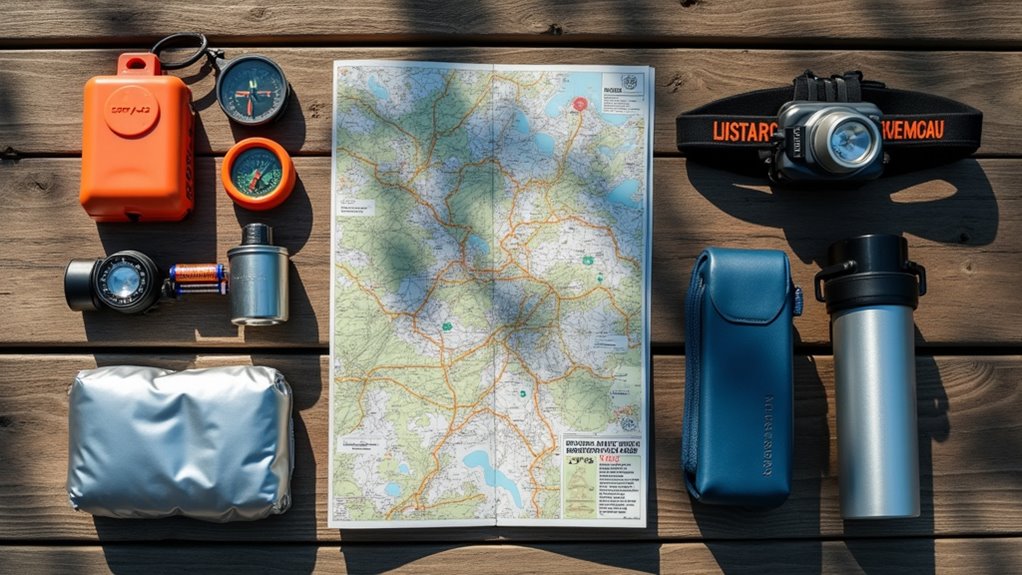
While hiking can be an enjoyable outdoor activity, carrying essential safety gear isn’t optional – it’s a critical part of responsible hiking.
Start with a well-stocked first aid kit containing bandages, antiseptics, and pain relievers. You’ll need an emergency shelter like a lightweight space blanket for unexpected weather changes. Don’t forget fire starters – matches or a lighter can be lifesaving in cold conditions. Consider carrying a satellite messenger for emergency communication in remote areas. Essential safety gear for your next camping adventure should also be considered.
A reliable multi-tool or knife will help you handle repairs and various trail situations. Pack extra clothing layers to adapt to temperature changes throughout your hike.
Consider these items your non-negotiable safety basics – they don’t need to be expensive, but they need to be dependable. You can find budget-friendly options for all these essentials at outdoor retailers or online marketplaces.
Three key navigation tools can help you stay on track during any hike: GPS devices, smartphone apps, and traditional map-compass combinations. You should prioritize devices with offline map access and long battery life for remote areas. Handheld GPS units offer reliability without cell service, while apps like Gaia GPS and Caltopo provide detailed topographic maps you can download beforehand.
Modern navigation apps provide extensive satellite coverage and high-resolution terrain data for comprehensive route planning. GPS is often considered a better camping and hiking choice than compass and map because it offers reliability without cell service. Don’t rely on just one tool – combine methods for safety and accuracy. Your smartphone with a navigation app works great, but pack a paper map and compass as backup. They’ll never run out of batteries or lose signal.
Before heading out, test your devices, download maps, and mark key waypoints. Remember to bring a portable charger or extra batteries to keep your electronics powered throughout your journey.
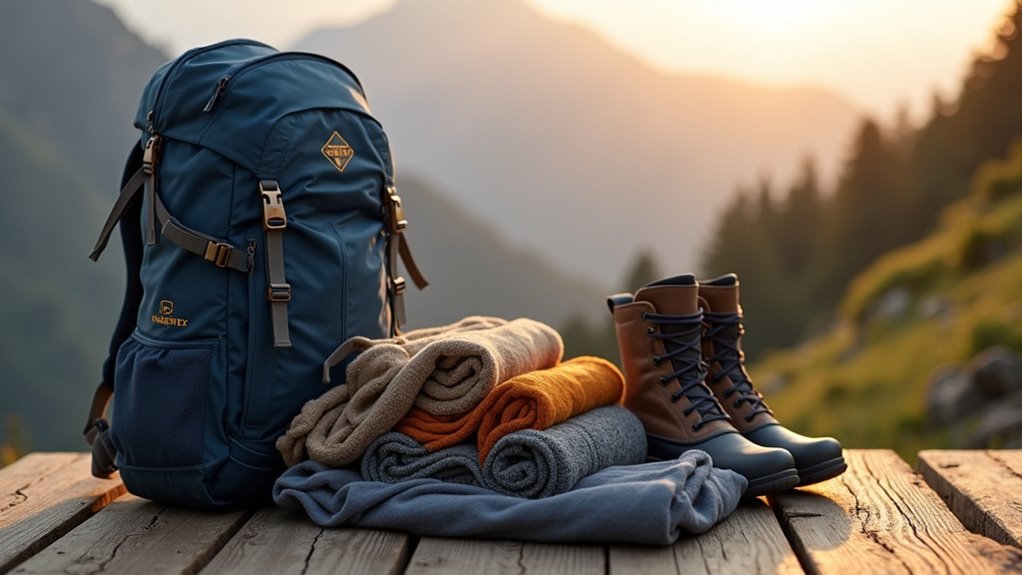
Having the right navigation tools keeps you on track, but proper clothing can make or break your hiking experience. You’ll stay comfortable and safe by mastering the art of layering your clothes.
Start with a moisture-wicking base layer that fits snugly against your skin – opt for synthetic or merino wool materials, never cotton. For hot weather hikes, choose UPF-rated clothing to protect against harmful sun exposure.
Add an insulating mid-layer like fleece or a lightweight puffy jacket to trap warmth. Top it off with a breathable, waterproof shell to shield you from wind and rain.
Don’t forget essential accessories: a warm beanie, moisture-wicking gloves, and gaiters for snowy conditions.
The key is adjusting these layers throughout your hike as your activity level and weather conditions change. Remove layers when you’re working hard, and add them back during rest stops to prevent overheating or getting chilled. Proper winter camping gear is essential for enjoying your outdoor adventures in cold weather.
Since proper hydration and nutrition can determine the success of your hiking adventure, selecting the right gear and planning your trail sustenance requires careful consideration.
Start with a 2-liter hydration bladder in a comfortable pack like the Osprey Skarab or Gregory Inertia. Women hikers should consider packs with contoured shoulder straps for enhanced comfort. You’ll want BPA-free materials and an easily cleanable wide opening.
Pack energy-dense snacks like nuts and dried fruits in lightweight containers, and plan to eat small portions frequently. Camping water filters can help ensure you have clean drinking water on the trail.
Don’t forget to monitor your hydration by drinking at regular intervals and watching for signs of dehydration. If you’re hiking in varying temperatures, invest in an insulated tube system to keep your water from freezing or getting too warm.
Remember to maintain electrolyte balance with appropriate supplements or snacks during longer treks.
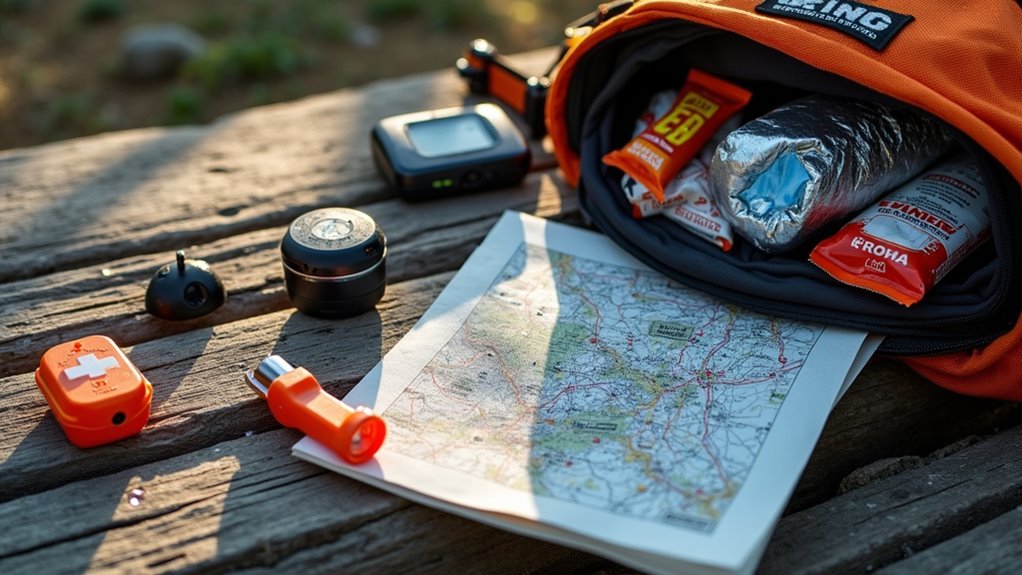
While nature offers incredible experiences, proper emergency preparedness can mean the difference between a minor setback and a serious crisis on the trail.
Start with an extensive first aid kit containing bandages, gauze, antiseptic wipes, and basic medications. Consider getting a Be Red Cross Ready kit as a reliable foundation for your supplies. Don’t forget your personal prescriptions and allergy treatments in waterproof containers.
A well-stocked first aid kit is your lifeline in the wilderness – pack it thoughtfully and keep medications dry.
You’ll need reliable communication tools: a fully charged phone, whistle, and signaling mirror. For remote areas, invest in a satellite device or PLB. Essential First Aid Supplies for your camping adventure should also be included.
Pack navigation essentials like a map and compass – and know how to use them before heading out.
Complete your emergency kit with multi-purpose items: duct tape, paracord, and a multi-tool. An emergency blanket and waterproof fire starter can be lifesavers if you’re forced to spend an unexpected night outdoors.
When starting on extended hiking adventures, you’ll need specialized overnight equipment that balances comfort with practicality.
Your shelter system and sleeping gear form the foundation of a safe overnight experience in the wilderness, while proper cooking equipment guarantees you’ll stay nourished on the trail. Pack a 30-50 liter backpack to ensure adequate space for all your overnight essentials.
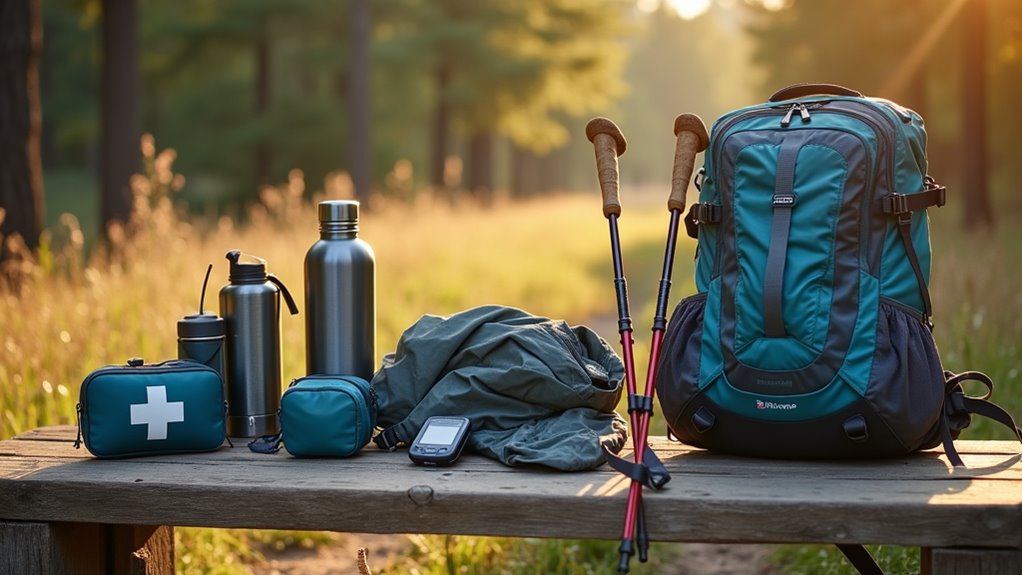
To make your hiking adventures both safe and enjoyable, you’ll need the right mix of essential accessories that prioritize comfort without breaking the bank. Start with a reliable headlamp for visibility during dawn, dusk, or unexpected delays.
Smart hikers balance safety and comfort with budget-friendly gear, starting with a dependable headlamp for low-light navigation.
Pack a high-SPF sunscreen and durable sunglasses to protect against harsh UV rays, along with a basic first-aid kit for minor emergencies. The Darn Tough Micro Crew socks provide exceptional comfort and durability for long days on the trail. Staying safe while camping outdoors is crucial, so be sure to pack necessary safety gear.
Don’t forget practical items like hand sanitizer, a lightweight trowel for bathroom needs, and trash bags to pack out waste. A multi-tool or knife will prove invaluable for various trail tasks.
Add water purification tablets to make natural water sources safe for drinking, and keep energizing trail snacks easily accessible. These affordable basics will enhance your hiking experience while keeping you prepared for common trail situations.
Different terrains demand specific gear choices that can make or break your hiking experience. Your footwear selection should match the trail conditions – opt for waterproof boots in wet conditions and lightweight trail runners on smoother paths. Consider wearing breathable synthetic materials to stay comfortable during your hike.
Don’t splurge on unnecessary gear; instead, focus on these terrain-specific essentials: Essential Gear for Your Next Hiking Adventure can help you determine the right equipment for your needs.
Remember to adapt your gear based on weather forecasts and trail reports to stay safe while keeping your pack weight manageable.
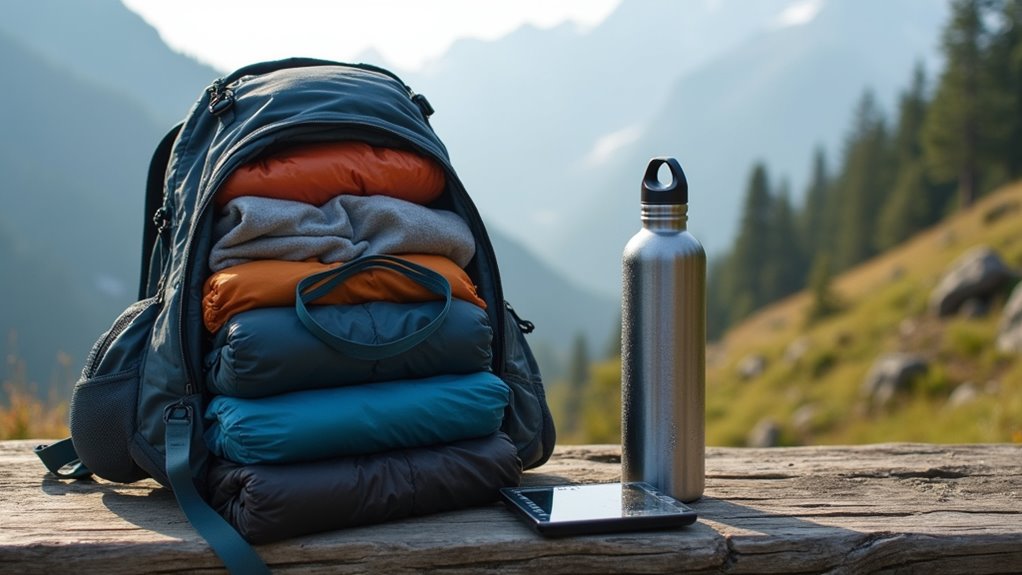
Managing your pack weight effectively starts with three fundamental principles: following weight guidelines, selecting lightweight gear, and optimizing your packing strategy.
Keep your loaded pack under 20% of your body weight for backpacking and 10% for day hiking. For example, if you weigh 150 pounds, aim for a maximum of 30 pounds for overnight trips and 15 pounds for day hikes.
Tracking your base weight category helps determine if your setup qualifies as ultralight, lightweight, or traditional backpacking gear. Essential camping supplies can be used to ensure you have the necessary gear for an unforgettable camping adventure.
You’ll greatly reduce strain by choosing modern lightweight packs, which can weigh as little as one pound.
Make every ounce count by using multipurpose gear and compression packing techniques. Create detailed packing lists to avoid bringing unnecessary items, and test your setup before long trips.
Remember that proper weight distribution within your pack can dramatically improve comfort and reduce fatigue during your hike.
You’ll find that proper hiking gear is your best investment in outdoor safety and enjoyment. Studies show that 77% of hiking incidents could have been prevented with adequate preparation and equipment. By focusing on essential gear while staying budget-conscious, you’re setting yourself up for worry-free adventures. Remember to start with the basics, build your kit gradually, and always prioritize safety-critical items before luxury gear.